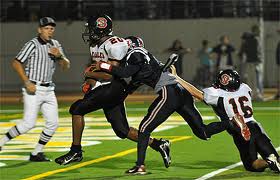Backround Research
The topic we decided to research is the mean weight of athletes. To make our study possible throughout our school, we chose to compare the mean weight of North Olmsted varsity fall athletes as compared to mean weight of North Olmsted varsity winter athletes. We believe that the mean weight of North Olmsted fall athletes is greater than the mean weight of North Olmsted winter athletes. Hence, our null hypothesis would be that the average weight of the two groups of athletes is equal. Our alternative hypothesis is that the average weight of the fall varsity athletes at NOHS is greater than the average weight of the winter varsity athletes at NOHS.
In order to obtain the proper background information, we looked up the mean weights of several professional athletes in different sports. The first sport we chose, and the main sport in the fall, is football. In article by Mens Health, “The Evolution of the Football Player”, an interesting statistic that was given was that “college interior linemen gained about 1 to 2 pounds per year over 60 years, and professional players gained up to 1.5 pounds year over 7 decades”. Although no statistics on the mean weight of the players was given in this study, we saw this study as beneficial because it made us understand that varsity athletes at NOHS, with hopes of playing college or even pro ball, need to gain weight. With the mindset that one must gain weight in order to participate at the highest level, we predict that the weights of NOHS football players will be on an increase and hence would be a lot larger than some sports in the winter where they must maintain their weight at a certain level, such as wrestling.
In order to contrast the most popular fall sport at NOHS, we decided to use the most popular winter sport at NOHS, basketball. The information we found was quite useful for our study. On NBA.com, the average weight of an NBA player found was 221.0 pounds. This statistic interested us, and we decided to try harder in our search for the average weight of players in NFL. Finally, after a lot of digging, we found it! According to SportingCharts.com, “In 2011, of the 1,948 active NFL players, the average weight was 247 pounds. There are a total of 426 players that weigh in at or over 300 pounds and a total of 5 players over the 350 pound mark.” Finding this information was a relief for us in our search for the answers of this study. Since the average weight of the two most popular sports at NOHS at the different periods is higher in the fall season with football, this was a stepping stone for us to conclude that this data may relate to our project beneficial to our alternate hypothesis.
However, these two sports would not suffice for our research since there are so many more sports to look at. The next sport we chose is golf. On a golf forum which took the top 200 players average weight from PGATour.com and calculated it to be 188 pounds. To contrast golf, we chose women’s gymnastics, since there is no men’s gymnastics at the high school (or nobody on the team). In a Los Angeles Times article, the weights of a total of 10 of the best gymnasts from both the American and Chinese team was given (5 each), we took these 10 weights and averaged them out, and obtained a 110.1 pound average. These two sports which are similar in popularity at NOHS at different seasons, both appear to have the smallest participants during their respective times, and have quite a huge difference in average weight. The weight of the fall sports athletes at a professional level are a lot greater than that of the winter sports. This helped us greatly with our argument.
Finally, we decided to take two sports that are similar in mechanics, cross country (distance running) and swimming. These two sports are both a race against time and require repetitive motion. In swimming, the swimmer is mostly using his arms as his legs compliment him. In running, the runner is mostly using his legs as his arms compliment him. We believe that this final comparison between average weights of these sports at professional levels will show us a result different from our hypothesis, thus making the difference between the fall and winter sports actually quite close. On SailWorld.com, the average male weight of an Olympic Swimmer appeared to be 185.85 pounds, while the average female weight of an Olympic Swimmer appeared to be 144.62 pounds. What we found about the average weight of a female marathon runner is 110.65 pounds and the average weight of a male marathon runner is 145.73 pounds, according to ncbi.gov and runcoachjason.com respectively. Although this data does not support our hypothesis, we saw it necessary to include it in order to show that the mean weight between the fall varsity sport athletes at NOHS and the winter varsity sport athletes at NOHS will be quite similar, although the fall athletes will surpass the winter athletes.
In general, we found the background information to be, although predictable, quite useful for a better understanding of how the weights should vary between these two groups. We believe that the average weight of the fall varsity athletes at NOHS will be greater than the average weight of the winter varsity athletes at NOHS but from this background information. We believe that the difference between these two average weights will not be as great as we first expected.
Works Cited
1.
http://news.menshealth.com/evolution-football-player/2013/01/04/
2.
http://www.nba.com/news/survey_2007.html
3.
http://www.sportingcharts.com/articles/nfl/top-5-heaviest-players-in-the-nfl.aspx
4.
http://www.freegolfinfo.com/forums/tm.aspx?m=148669
5.
http://latimesblogs.latimes.com/olympics_blog/2008/08/sizing-up-the-t.html
6.
http://www.sail-world.com/index.cfm?Nid=96614&refre=y&ntid=0&rid=4
7.
http://www.ncbi.nlm.nih.gov/pmc/articles/PMC1478381/?page=2